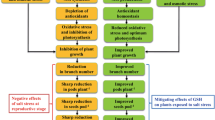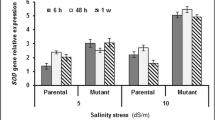Abstract
Salt stress is one of the main environmental factors inhibiting the growth of plants because it adversely disturbs the balance between reactive oxygen species content and antioxidant defense, causing oxidative stress. In this research, the effect of salt stress at different concentrations of NaCl (3, 6, 9 dS m−1) was investigated on 5 mung bean genotypes (9, 1015, 1018, 1021 and Gohar), specifically for antioxidant activity and proline content. In this regard, the relative expression of key genes involved in proline synthesis (P5 CS, P5CR) and degradation (PDH) were also studied in the leaves of tolerant genotype (1015) and susceptible genotype (9) by qRT-PCR under only 9 dS m−1 NaCl. Given the results, the activity of antioxidant enzymes, including ascorbate peroxidase, catalase, and guaiacol peroxidase significantly were increased particularly in genotype 1015 under 9 dS m−1 NaCl. Salinity stress led the elevation of proline contents. As a result, proline accumulation increased due to P5 CS, P5CR upregulation, and PDH down-regulation. On the other hand, incrementing proline in tolerant genotype (1015) versus susceptible genotype (9) implicates the key role of proline in salinity stress withstanding. Conclusively, the study results could be efficiently applicable in advance plant breeding programs.






Similar content being viewed by others
References
Abdallah M, Ramadan A, El-Bassiouny H, Bakry B (2020) Regulation of antioxidant system in wheat cultivars by using chitosan or salicylic acid to improve growth and yield under salinity stress. Asian J Plant Sci 19:114–126
Abogadallah GM, Serag MM, Quick WP (2010) Fine and coarse regulation of reactive oxygen species in the salt tolerant mutants of barnyard grass and their wild-type parents under salt stress. Physiol Plant 138:60–73
Aebi H (1984) [13] Catalase in vitro. Meth Enzymol 105:121–126
Alharby HF, Al-Zahrani HS, Hakeem KR, Iqbal M (2019) Identification of physiological and biochemical markers for salt (NaCl) stress in the seedlings of mungbean [Vigna radiata (L.) Wilczek] genotypes. Saudi J Biol Sci 26:1053–1060
Arif Y, Singh P, Siddiqui H, Bajguz A, Hayat S (2020) Salinity induced physiological and biochemical changes in plants: an omic approach towards salt stress tolerance. Plant Physiol Biochem 156:64–77
Armon D (1949) Copper enzymes in isolated chloroplasts. Polyphenoloxidase in Beta vulgaris. Plant Physiol 24:1–15
Arzani A, Ashraf M (2016) Smart engineering of genetic resources for enhanced salinity tolerance in crop plants. CRC Crit Rev Plant Sci 35:146–189
Ashraf M, Ali Q (2008) Relative membrane permeability and activities of some antioxidant enzymes as the key determinants of salt tolerance in canola (Brassica napus L.). Environ Exp Bot 63:266–273
Ashraf M, Foolad MR (2007) Roles of glycine betaine and proline in improving plant abiotic stress resistance. Environ Exp Bot 59:206–216
Bates LS, Waldren RP, Teare I (1973) Rapid determination of free proline for water-stress studies. Plant Soil 39:205–207
Berova M, Zlatev Z, Stoeva N (2002) Effect of paclobutrazol on wheat seedlings under low temperature stress. Bulg J Plant Physiol 28:75–84
Chaitanya K, Sundar D, Masilamani S, Reddy AR (2002) Variation in heat stress-induced antioxidant enzyme activities among three mulberry cultivars. Plant Growth Regul 36:175–180
Chance B, Maehly AC (1955) Assay of catalase and peroxidase. Meth Enzymol 2:764–775
Dastneshan S (2019) Evaluation of tolerance rate of some genotypes of beans (Phaseolus vulgaris L.) to salinity stress. J Crop Breed 11:184–194
Doğru A, Canavar S (2020) Physiological and biochemical components of salt tolerance in plants. Acad Platf J Eng Sci 8:155–174
Gill SS, Tuteja N (2010) Reactive oxygen species and antioxidant machinery in abiotic stress tolerance in crop plants. Plant Physiol Biochem 48:909–930
Goharrizi KJ, Baghizadeh A, Afroushteh M, Amirmahani F, Kermani SG (2020) Effects of salinity stress on proline content and expression of ∆1-pyrroline-5-carboxylate synthase and vacuolar-type H+ subunit E genes in wheat. Plant Genet Resour 18:334–342
Gupta B, Huang B (2014) Mechanism of salinity tolerance in plants: physiological, biochemical, and molecular characterization. Int J Genomics. https://doi.org/10.1155/2014/701596
Hasanuzzaman M et al (2020) Reactive oxygen species and antioxidant defense in plants under abiotic stress: revisiting the crucial role of a universal defense regulator. Antioxidants 9:681
Hayat S, Hayat Q, Alyemeni MN, Wani AS, Pichtel J, Ahmad A (2012) Role of proline under changing environments: a review. Plant Signal Behav 7:1456–1466
Jebara S, Jebara M, Limam F, Aouani ME (2005) Changes in ascorbate peroxidase, catalase, guaiacol peroxidase and superoxide dismutase activities in common bean (Phaseolus vulgaris) nodules under salt stress. J Plant Physiol 162:929–936
Kaur L, Asthir B, Bains N (2019) Salt tolerant wheat landraces and Gly II transformed lines show distinct biochemical mechanisms of stress tolerance. Cereal Res Commun 47:264–276
Kumar S et al (2021) Effect of salt stress on growth, physiological parameters, and ionic concentration of water dropwort (Oenanthe javanica) cultivars. Front Plant Sci 12:660409
Liang W, Ma X, Wan P, Liu L (2018) Plant salt-tolerance mechanism: a review. Biochem Biophys Res Commun 495:286–291
Misra N, Saxena P (2009) Effect of salicylic acid on proline metabolism in lentil grown under salinity stress. Plant Sci 177:181–189
Motamed N (2014) Increase of P5 CS gene expression in olive plantlets under salinity stress. J Cell Mol Res (Iran J Biol) 27:119–124
Naliwajski M, Skłodowska M (2021) The relationship between the antioxidant system and proline metabolism in the leaves of cucumber plants acclimated to salt stress. Cells 10:609
Omrani B, Moharramnejad S (2018) Study of salinity tolerance in four maize (Zea mays L.) hybrids at seedling stage. J Crop Breed 9:79–86
Per TS, Khan NA, Reddy PS, Masood A, Hasanuzzaman M, Khan MIR, Anjum NA (2017) Approaches in modulating proline metabolism in plants for salt and drought stress tolerance: phytohormones, mineral nutrients and transgenics. Plant Physiol Biochem 115:126–140
Pfaffl MW, Horgan GW, Dempfle L (2002) Relative expression software tool (REST©) for group-wise comparison and statistical analysis of relative expression results in real-time PCR. Nucl Acids Res 30:e36
Qareqani Pour N, Shiran B, Khoddam Bashi M, Molaei A (2015) Study of proline accumulation and gene expression of P5 CS in leaves and flower buds of common bean cultivars under drought stress. Agric Biotechnol J 6:129–142
Qiu H, Zhang L, Liu C, He L, Wang A, Liu H‑L, Zhu J‑B (2014) Cloning and characterization of a novel dehydrin gene, SiDhn2, from Saussurea involucrata Kar. et Kir. Plant Mol Biol 84:707–718
Rajput VD et al (2021) Recent developments in enzymatic antioxidant defence mechanism in plants with special reference to abiotic stress. Biology 10:267
Saha P, Chatterjee P, Biswas AK (2010) NaCl pretreatment alleviates salt stress by enhancement of antioxidant defense system and osmolyte accumulation in mungbean (Vigna radiata L. Wilczek). Indian J Exp Biol 48(6):593–600
Sehrawat N, Yadav M, Sharma AK, Kumar V, Bhat KV (2019) Salt stress and mungbean [Vigna radiata (L.) Wilczek]: effects, physiological perspective and management practices for alleviating salinity. Arch Agron Soil Sci 65:1287–1301
Skopelitis DS et al (2006) Abiotic stress generates ROS that signal expression of anionic glutamate dehydrogenases to form glutamate for proline synthesis in tobacco and grapevine. Plant Cell 18:2767–2781
Szabados L, Savouré A (2010) Proline: a multifunctional amino acid. Trends Plant Sci 15:89–97
Tavakoli M, Poustini K, Alizadeh H (2016) Proline accumulation and related genes in wheat leaves under salinity stress. J Agric Sci Technol 18:707–716
Van Zelm E, Zhang Y, Testerink C (2020) Salt tolerance mechanisms of plants. Annu Rev Plant Biol 71:403–433
Velikova V, Yordanov I, Edreva A (2000) Oxidative stress and some antioxidant systems in acid rain-treated bean plants: protective role of exogenous polyamines. Plant Sci 151:59–66
Xie E, Wei X, Ding A, Zheng L, Wu X, Anderson B (2020) Short-term effects of salt stress on the amino acids of Phragmites australis root exudates in constructed wetlands. Water 12:569
Yildiz M, Terzi H (2013) Effect of NaCl stress on chlorophyll biosynthesis, proline, lipid peroxidation and antioxidative enzymes in leaves of salt-tolerant and salt-sensitive barley cultivars. J Agric Sci 19:79–88
Zeeshan M, Lu M, Sehar S, Holford P, Wu F (2020) Comparison of biochemical, anatomical, morphological, and physiological responses to salinity stress in wheat and barley genotypes deferring in salinity tolerance. Agronomy 10:127
Acknowledgements
We appreciate the University of Tehran for supporting the current research
Funding
This study was funded by University of Tehran with grant number: 7101007/6/05
Author information
Authors and Affiliations
Contributions
Corresponding author declares that all co-authors equally contributed to ending up this study until obtaining results and preparing manuscript. Contribution details follows here: Concept design; Manijeh Sabokdast Nodehi, and Alireza Abbasi., Material and methods; Nasim Khalifeh, Data analysis; Sajjad Sobhanverdi, and Nasim Khalifeh., Manuscript preparation; Manijeh Sabokdast Nodehi, and Sajjad Sobhanverdi.
Corresponding author
Ethics declarations
Conflict of interest
N. Khalifeh, M. Sabokdast Nodehi, A. Abbasi and S. Sobhanverdi declare that they have no competing interests.
Additional information
Availability of data and materials
All results clearly is stated in this manuscript and original data are available any time the journal editor in chief wants.
Consent for Publication: All authors accepted this version to publish.
Supplementary Information
Rights and permissions
Springer Nature or its licensor holds exclusive rights to this article under a publishing agreement with the author(s) or other rightsholder(s); author self-archiving of the accepted manuscript version of this article is solely governed by the terms of such publishing agreement and applicable law.
About this article
Cite this article
Khalifeh, N., Sabokdast Nodehi, M., Abbasi, A. et al. Mung Bean Genotypes Demonstrate a Correlative Response at Biochemical and Molecular Level Under Salinity Stress. Gesunde Pflanzen 75, 911–919 (2023). https://doi.org/10.1007/s10343-022-00735-x
Received:
Accepted:
Published:
Issue Date:
DOI: https://doi.org/10.1007/s10343-022-00735-x




